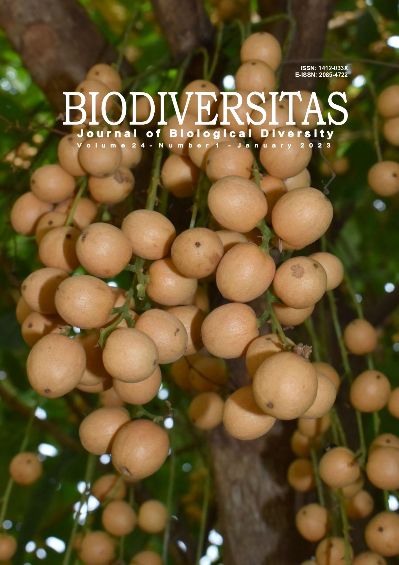Genetic diversity, heritability, and accumulation patterns of Zn content in biofortified rice
##plugins.themes.bootstrap3.article.main##
Abstract
Abstract. Rohaeni WR, Suwarno WB, Susanto U, Trikosoemaningtyas, Ghulamahdi M, Aswidinnoor H. 2023. Genetic diversity, heritability, and accumulation patterns of Zn content in biofortified rice. Biodiversitas 24: 208-214. The study on zinc accumulation patterns in various rice organs is valuable information to support effective biofortified breeding. Research reports related to zinc accumulation have only been limited to seeds, while the pattern of zinc accumulation in each part of the plant has not been reported, especially for Indonesian rice germplasm. The study aims to provide information on the pattern of accumulation and genetic diversity of Zn content in rice plants. The experiments used a randomized complete block design (RCBD) with 3 replications and genotypes as a treatment. The genotypes were 29 lines of BC4F3 Inpari IR Nutri Zinc////Inpari 23, 5 lines of BC4F3 Inpari IR Nutrizinc////Sintanur, and 1 line of BC4F3 Inpari IR Nutrizinc////Inpari 35. A total of 6 varieties were used as checks. The Zn content of dehulled (brown rice) grains sample was measured using the Oxford Supreme8000 XRF machine with the Rice15 method that had been validated by the Inductively Coupled Plasma (ICP) method, while the analysis of the pattern of Zn content of several organs (seeds, leaves, stems, and roots) used the Inductively Coupled Plasma Optical Emission Spectrometry (ICP-IOS) method. The coefficient of genetic variation of the grain zinc content (GZn) was moderate and had high heritability criteria (H2bs = 0.83). Yield characters have a narrow coefficient of genetic variation and low heritability. There were differences in the pattern of Zn accumulation in plant organs between high GZn and low GZn genotypes. The distribution of Zn content in high GZn genotypes showed 26.4% in seeds, 13.7% in leaves, 39.3% in stems, and 20.6% in roots. The distribution of Zn content in low GZn genotypes showed 14.2% in seeds, 10.9% in leaves, 31.0% in stems, and 44.0% in roots. The results of this study indicate that a different breeding strategy is needed to develop new high-yielding rice varieties based on zinc accumulation patterns in cross-parents.

